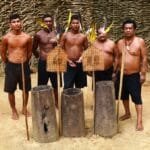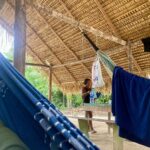

Rio de Janeiro is the second largest city in Brazil, on the South Atlantic coast. Rio is famous for its breathtaking landscape, its laid-back beach culture and its annual carnival. The “Carioca Landscapes between the Mountain and the Sea” has been inscribed on the UNESCO World Heritage list.
The harbour of Rio de Janeiro is comprised of a unique entry from the ocean that makes it appear as the mouth of a river. Additionally, the harbor is surrounded by spectacular geographic features including Sugarloaf mountain at 395 meters (1,296 feet), Corcovado Peak at 704 meters (2,310 feet), and the hills of Tijuca at 1,021 meters (3,350 feet). These features work together to collectively make the harbor one of the Seven Natural Wonders of the World.
Rio de Janeiro hosted many of the 2014 FIFA World Cup games, including the final. It also hosted the 2016 Summer Olympics and Paralympics, becoming the first South American city to host the Summer Olympics.


Although located across Guanabara Bay, one of Rio’s best views (one that includes both the Christ and the Sugarloaf in your camera frame) can be seen from this Museum in Niteroi, a neighboring city only 15 minutes away from downtown Rio by ferry boat.


There is no shortage of things to do on a rainy day. In addition to a wide range of museums, Rio has many cultural centres, which are run by banks and other organizations and usually host free exhibitions. Details of what is on can be found in the Segundo Caderno section of the daily O Globo newspaper, which provides more detail in a weekly Friday supplement. Also very useful is the Mapa das Artes Rio de Janeiro, which provides detailed bi-monthly listings as well as detailed maps of the city. This is free and can be picked up at most museums.
Aerial view of downtown Rio and surroundings where most historic buildings and museums can be found.

Sambodrome at night. Here thousands spend the night dancing, singing and celebrating their favorite samba school (comparable to soccer teams) till dawn.
Still the greatest reason for visiting Rio seems to be the Carnaval. This highly-advertised party lasts for almost two weeks and it is well known for the escolas de samba (samba schools) that parade in Centro, on a gigantic structure called Sambódromo(Sambadrome). During Carnaval, Rio has much more to offer though, with the blocos de rua, that parade on the streets. There are now hundreds of these street “samba blocks”, that parade almost in every neighborhood, especially in Centro and the South Zone, gathering thousands of people. Some are very famous, and there are few cariocas that have not heard of “Carmelitas”, “Suvaco de Cristo”, “Escravos da Mauá” or “Simpatia É Quase Amor”.
The rest of the year, samba shows are popular with tourists, and are held at several venues like Plataforma and Scala. These are expensive and not really representative of Brazilian culture, they present a lot of almost naked women and bad musicians, a tourist trap (much like the real thing.) Much more interesting and genuine, though, are the night practice sessions held by the various samba schools in the months leading up to Carnaval. You will find only a small number of tourists here, and you will be served the best caipirinhas of your trip! These go on into the wee hours of the morning, with the fun really only starting at 1-2AM A good cab driver should be able to hook you up, and cabs will be available to take you back when you are samba-ed out. Salgueiro and Mangueira are good choices, as they are two of the larger samba schools, and are located relatively close to the tourist areas in a fairly safe area.
A change is afoot that may make this genuine experience a thing of the past (or more convenient, depending on your viewpoint) for all but the most savvy tourists. The local government built a complex of buildings (Cidade do Samba) where many of the samba schools are moving their practice halls and float-construction facilities from the gritty warehouses typically located in or near their home favelas. One can expect many more tourists, and shows made-up for the tourists as the tourist bureau milks this facility for all it’s worth year-round.












Site Desenvolvido por: 🚀 Agência Digital HGX Criação de Sites e Marketing Digital Criação de Sites e Marketing Digital
Obrigado pelo seu contato, retornaremos em breve! Thank you for contacting us, we will get back to you shortly!
Inscreva-se na minha newsletter para ver novas fotos, dicas e postagens do blog.